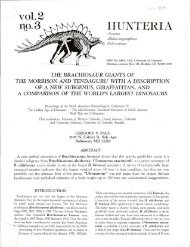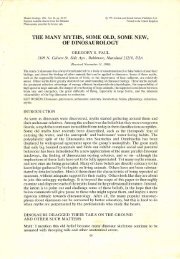Dinosaur models: the good, the bad, and using - Gregory S. Paul
Dinosaur models: the good, the bad, and using - Gregory S. Paul
Dinosaur models: the good, the bad, and using - Gregory S. Paul
You also want an ePaper? Increase the reach of your titles
YUMPU automatically turns print PDFs into web optimized ePapers that Google loves.
132<br />
Where Models-Especially Commercial Examples-Go Wrong<br />
Most artistic <strong>and</strong> commercial dinosaur <strong>models</strong> do not meet<br />
<strong>the</strong> above criteria, mainly because any skeletal restorations <strong>the</strong>y<br />
are based upon are rarely published. In order to assess <strong>the</strong> accuracy<br />
of some inadequately documented <strong>models</strong>, <strong>the</strong> profiles of<br />
British Museum of Natural History (BMNH) commercial <strong>models</strong><br />
are compared to same scale technical skeletal-muscle restorations<br />
(Figures 2 & 3). The results not only show that <strong>the</strong> <strong>models</strong><br />
are inaccurate to <strong>the</strong> point of being caricatures (<strong>Paul</strong>, 1990),<br />
<strong>the</strong>y also reveal why. Major variations in restored volume are<br />
not, as commonly thought (Alex<strong>and</strong>er, 1989), primarily due to<br />
<strong>the</strong> differing interpretations of muscle <strong>and</strong> o<strong>the</strong>r soft tissue bulk<br />
that result from "artistic license". Overly large chests (see below)<br />
inflate trunk volume by only 10-15%. It is <strong>the</strong> trunk that<br />
makes of most of an animal's volume, so mass estimates are not<br />
highly dependent upon <strong>the</strong> volume of appendages. Example: in<br />
sauropods big necks <strong>and</strong> tails usually make up about 20% of<br />
total mass, so arbitrarily increasing <strong>the</strong>ir volumes by half only<br />
increases total mass by 10%. If as much muscle <strong>and</strong> fat as is<br />
marginally conceivable is applied to dinosaurs, total volume can<br />
be boosted by at most 20% above <strong>the</strong> values presented in this<br />
study. By <strong>the</strong> same token, if a marginally emaciated condition<br />
is accepted about 20% can be shaved off. Greater differences in<br />
volume are due to gross errors in proportions <strong>and</strong>/or scale of <strong>the</strong><br />
degree observed in <strong>the</strong> commercial <strong>models</strong>.<br />
Protocol Employed in This Study<br />
The methods for rigorously restoring fossil skeletons <strong>and</strong><br />
musculature are detailed in <strong>Paul</strong> (1987, 1988a,b) <strong>and</strong> <strong>Paul</strong> &<br />
Chase (1989). Restorations are based on figures <strong>and</strong>/or photographs<br />
of bones <strong>and</strong>/or complete mounts, careful attention has<br />
been paid to reproducing <strong>the</strong> dimensions of both. The more complete<br />
a skeleton is <strong>the</strong> better, <strong>the</strong>re is no simple cut off point at<br />
which a species' skeleton becomes too poorly known to be modeled<br />
accurately. The absence of dozens of tail vertebrae is less<br />
serious than <strong>the</strong> absence of <strong>the</strong> dozen vertebrae that make up<br />
<strong>the</strong> trunk. A skeleton that lacks 55% of its bones, but whose<br />
remaining 45% includes almost all elements from one side<br />
(which can be used to model <strong>the</strong> missing side) is superior to a<br />
skeleton that lacks <strong>the</strong> front 30%. When modeling a dinosaur, it<br />
is especially critical to properly articulate <strong>and</strong> space <strong>the</strong> vertebrae<br />
so that <strong>the</strong> length of <strong>the</strong> articulated spinal column is correct<br />
(in general, <strong>the</strong> spool-shaped centra of vertebrae are separated<br />
by thin cartilagenous disks in life). When parts from different<br />
skeletons of different sizes have to be put toge<strong>the</strong>r <strong>the</strong>y must be<br />
"cross-scaled" so that <strong>the</strong>y are drawn to a common size. This<br />
produces a composite skeleton whose proportions are as accurate<br />
as possible with <strong>the</strong> remains on h<strong>and</strong>. Beware skeletal mounts<br />
that include unmodified parts from individuals of different sizes.<br />
It is not possible to accurately restore individual muscles in<br />
extinct tetrapods (McGowan, 1979; <strong>Paul</strong>, 1987, 1988a,b; Bryant<br />
<strong>and</strong> Seymour, 1990), so <strong>the</strong> gross superficial musculature has<br />
been profiled in solid black (living animals were used as partial<br />
guides, sources include Knight [1947]; Ellenberger et al. [1949];<br />
Kingdon [1979]). When not covered by fea<strong>the</strong>rs or thick fur,<br />
many predators <strong>and</strong> herbivores have a "bony" appearance. The<br />
tips of <strong>the</strong> neural spines <strong>and</strong> ribs lie just beneath <strong>the</strong> skin, <strong>the</strong><br />
outermost edges of some girdle <strong>and</strong> limb bones such as <strong>the</strong> dorsal<br />
end of <strong>the</strong> scapula <strong>and</strong> <strong>the</strong> ilium form prominent contours,<br />
<strong>and</strong> <strong>the</strong> ribs are sometimes visible even when <strong>the</strong> animal is<br />
healthy. The figures represent <strong>the</strong> subjects in "prime-lean" condition,<br />
with healthy, full bodied muscles <strong>and</strong> little fat. In tropical<br />
nondomestic l<strong>and</strong> animals, both small <strong>and</strong> large, fat is only about<br />
4% of total mass (Ledger, 1968; Albl, 1971; Owen-Smith, 1988;<br />
Haynes, 1991; Shoshoni, pers. comm.; even hippos are only<br />
Dinofest:®>International Proceedings<br />
10% fat; <strong>the</strong> heavy fat deposits postulated by <strong>Paul</strong> [1988a] are<br />
excessive). Predators are modeled with empty, hollow bellies<br />
(paul [1988b]; o<strong>the</strong>rwise, <strong>the</strong>ir latest victim would be part of <strong>the</strong><br />
mass estimate!). Herbivores usually keep at least some fodder<br />
in <strong>the</strong>ir guts <strong>and</strong> are modeled in this manner, but this amounts<br />
to only about 2% of <strong>the</strong> total mass (Laws et al., 1975).<br />
The dimensions <strong>and</strong> volume represented by <strong>the</strong> skeletal restorations<br />
were translated into half-figure plasticine <strong>models</strong>. Halffigure<br />
<strong>models</strong> save time-because <strong>the</strong>y lack an armature, <strong>and</strong><br />
<strong>the</strong>ir volume can be measured easily-but <strong>the</strong> primary advantage<br />
is that rendering <strong>the</strong> model directly atop a sagittal body<br />
plan facilitates accurate reproduction of body dimensions on all<br />
axes. Models were constructed solely to reproduce <strong>the</strong> volume<br />
of multi-view paper restorations; <strong>the</strong>y were not independent restorations<br />
of volume, nor of artistic quality. The skeletal-muscle<br />
figures are <strong>the</strong> sole record of <strong>the</strong> volume estimate because <strong>the</strong><br />
plasticine figures were cut into small sections, any holes were<br />
sealed, <strong>and</strong> <strong>the</strong>ir volume was measured at least twice with an<br />
accuracy of ±2% in water filled graduated cylinders. Results<br />
were fur<strong>the</strong>r checked by copying <strong>the</strong> skeletal restorations ei<strong>the</strong>r<br />
to <strong>the</strong> same scale, or to a common st<strong>and</strong>ard such as shoulder<br />
height or femur length, <strong>and</strong> overlaying <strong>the</strong> two skeletons on a<br />
back lit glass to visually compare relative volumes.<br />
If l<strong>and</strong> animals had <strong>the</strong> same density as water, <strong>the</strong>ir volume<br />
could be translated into mass on a one-to-one basis (as per Alex<strong>and</strong>er,<br />
1989). However, most animals float, so specific gravity<br />
(SG) is usually about 0.95. Pneumatic vertebrae suggest some<br />
dinosaurs were less dense. Early <strong>the</strong>ropods are assigned an SG<br />
of 0.9, <strong>and</strong> <strong>the</strong> value used for more advanced <strong>the</strong>ropods with<br />
more extensive air-sacs is 0.85 (<strong>Paul</strong>, 1988b). The main body of<br />
sauropods was probably less filled with air-sacs than birds, so<br />
<strong>the</strong>ir general SG is set at 0.9 (<strong>Paul</strong>, 1988a). However, <strong>the</strong> intensely<br />
pneumatic neck vertebrae mean <strong>the</strong>ir necks were even<br />
less dense. If this is not taken into account <strong>the</strong>n <strong>the</strong> estimated<br />
mass of large necked sauropods will be too high relative to .<br />
smaller necked forms. The SG of sauropod necks is <strong>the</strong>refore<br />
set at 0.6 (which may be too high, <strong>Paul</strong> [1988a]). In any case,<br />
<strong>the</strong> possible error involved with specific gravity is modest.<br />
Using Living Animals to Test <strong>the</strong> Protocol<br />
Farlow (1980) suggested that <strong>the</strong> accuracy of volumetric <strong>models</strong><br />
be tested by modeling modern forms, <strong>and</strong> seeing how closely<br />
<strong>the</strong> resulting mass estimates correspond with reality. Carpenter<br />
(1988) expressed concern over <strong>the</strong> accuracy of half-figure <strong>models</strong>.<br />
Two large mammals were selected for modeling<br />
(AppendFigs. 6,8). In both <strong>the</strong> side views are based on mounted<br />
skeletons <strong>and</strong> photographs of living animals, <strong>the</strong> top views on<br />
aerial or fore-<strong>and</strong>-aft views of living animals. Secrecy <strong>and</strong> exaggeration<br />
by showman P. T Barnum surrounds <strong>the</strong> size of <strong>the</strong><br />
ponderous pachyderm Jumbo (Shoshoni et al., 1986). The restored<br />
height of 3.2 m is less than past height estimates, but is<br />
tall for a still growing bull of Jumbo's age. Despite great mass,<br />
slow moving proboscideans do not have an exceptionally heavy<br />
limb musculature (Knight, 1947; Kingdon, 1979; Haynes, 1991).<br />
Laws et a1.'s (1985) data indicates a 5.8 ± 1.0 tonne mass for<br />
3.18 rn tall bulls in <strong>good</strong> condition. The model based estimated<br />
mass of 6.2 tonnes for Jumbo is <strong>the</strong>refore only 7% higher than<br />
<strong>the</strong> predicted mean, <strong>and</strong> within <strong>the</strong> range for an animal of its<br />
height. In rhinos <strong>the</strong> ventral profile of <strong>the</strong> abdomen follows a<br />
simple semi-circular arc down from <strong>the</strong> pubis (Figures 2.3,7.5<br />
<strong>and</strong> o<strong>the</strong>rs in Owen-Smith, 1988), ra<strong>the</strong>r than <strong>the</strong> more complex,<br />
baggier belly seen in elephants. Also, <strong>the</strong> leg muscles of galloping<br />
rhinos are more powerfully built than those of elephants.<br />
The estimated 1 tonne mass of an Indian rhino is only 5% higher<br />
than <strong>the</strong> mean value, <strong>and</strong> within <strong>the</strong> 0.8 to 1.0 tonne range,<br />
predicted for a specimen of its shoulder height.









